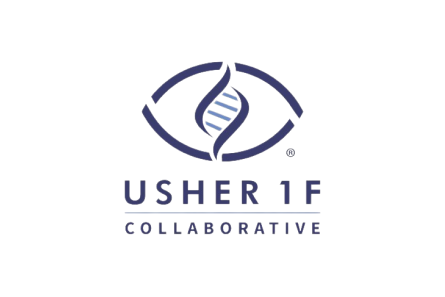Usher 1F Collaborative
Cycle 1
Usher Syndrome is the leading cause of inherited deaf-blindness, and type 1 is the most severe. Children with Usher 1 are born profoundly deaf with poor balance and progressively lose their sight.
Last updated May 2024
Clinical
Disease Class
Rare genetic diseases
Rare ophthalmic diseases
Rare otorhinolaryngological diseases
Body Systems
Nervous / Sensory
Organs
Ears
Eyes
Genes
ADGRV1 (VLGR1)
CDH23
CIB2
HARS1
MYO7A (USH1B)
PCDH15 (USH1F)
SANS (USH1G)
USH1C
USH2A
USH3A (CLRN1)
WHRN (DFNB31)
Type of Inheritance
Autosomal recessive
Disease Mechanism(s)
Pathogenic mutation
Age of Onset
Prebirth
Incidence
Less than 10
Prevalence
101-1000
Populations and/or ancestry with higher prevalence
Ashkenazi Jews
Symptoms / Phenotypes
balance problems
hearing loss / hearing impairment
vision problems
Biomarkers
Diagnostic
· profound deafness at birth, low muscle tone -> late gross motor milestone
Monitoring
· progression of vision loss - loss of night vision followed by narrowing peripheral vision
Prognostic
· Auditory brainstem response hearing test, electroretinogram, behavioral hearing test, visual field test
Existing Therapies
Alternative treatments (eg. nutritional supplements)
· DHA, N-Acetyl Cysteine
Drugs approved for the symptoms
Organizational & Research
Cell Lines
Organoids
Cell Lines, location
Centre for Eye Research Australia (CERA)
Institute of Molecular and Clinical Ophthalmology
University of Iowa
Cell Lines, share
IDK
Disease Model
Mouse
Zebrafish
Disease Model, location
Harvard Medical School
Oregon Institute of Neuroscience
University of Maryland School of Medicine
Disease Model, share
Yes
Clinical Trial Role
Data analysis
Data sharing
Biobank
None
Center of Excellence
None
Registry
Yes, we have collaborated on a registry
Data Collected, Registry
Clinical data
Electronic health records/electronic medical records
Genetic data
Patient contact info
Patient-reported data
Data Entered by, Registry
Both
Platform, Registry
RARE-X
Natural History Study
Yes, we have collaborated on a natural history study
Data Collected, Natural History Study
Clinical endpoints (outcomes)
Genetic data
Imaging data
Prospective data
Platform, Natural History Study
Other
FDA Patient Listening Session
No
FDA Patient-Focused Drug Development (PFDD) Program
No
ICD Codes
We are working on obtaining an ICD-10 code
Yes, we have an ICD-11 code specific to our exact disease
Diagnostic Guidelines
No
Clinical/Treatment Guidelines
No
Organizational Roles
Director of Operations/Director of Development
Executive Director
Science Advisory Board Policies
No policies
Research Network Policies
Has CRN but no policies
Research Roadmap
Yes we have a Research Roadmap, and will share policies
International Partners
North America
Oceania
